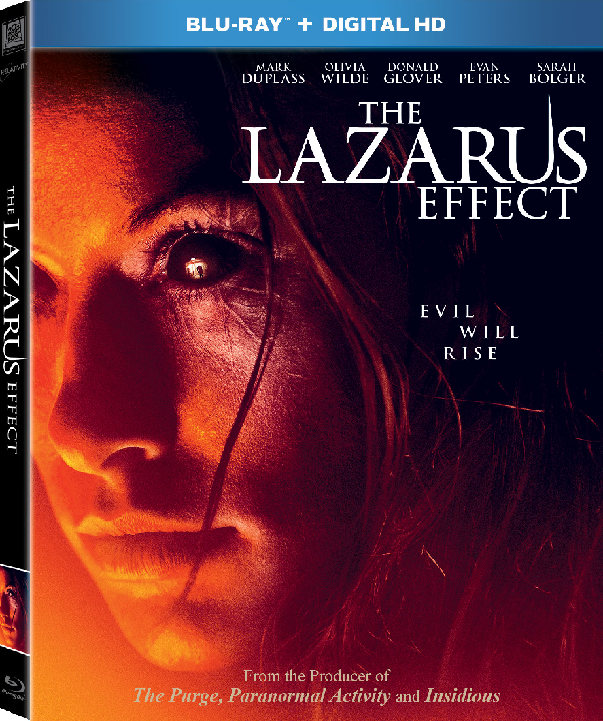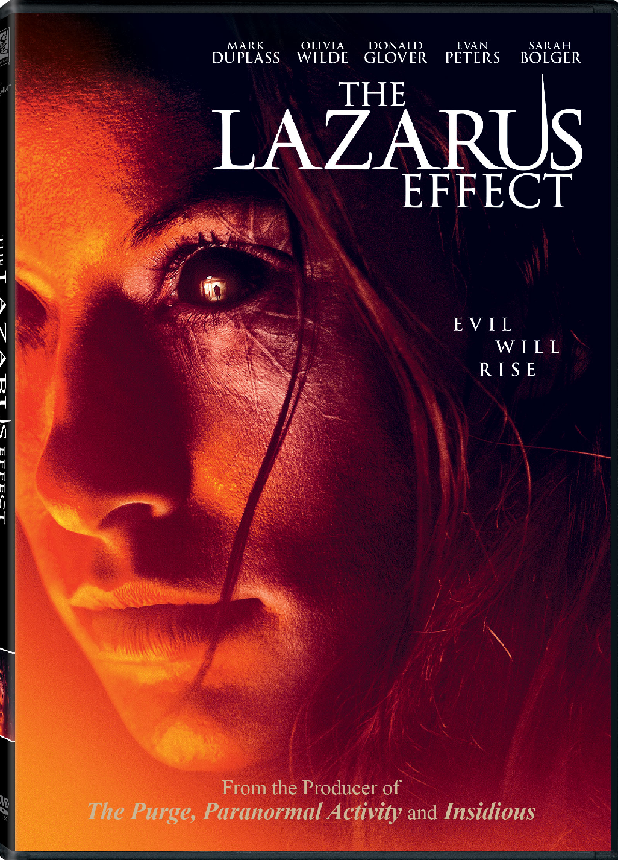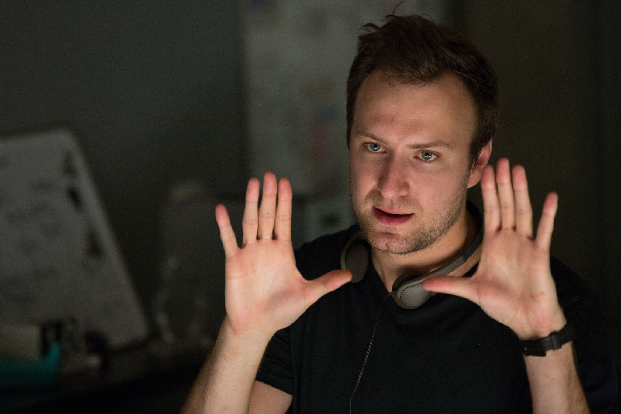The alluring potential to be the first to uncover humanity’s most desirable scientific achievement-reversing the finality of death, and finally capturing the elusive and desirable fate of immortality-is an engrossing concept that has driven many diverse films. Director David Gelb’s supernatural horror thriller, ‘The Lazarus Effect,’ which is set to be released on Blu-ray and DVD on Tuesday, not only captivatingly explores that riveting idea, but also compellingly explores the question of whether opening the gap between life and death ultimately leads to the unleashing of an indestructible evil. The film grippingly shows that while reawakening the dead is meant to reunite separated loved ones, it actually leads to the darkest corners of the human psyche and mortal fear.
‘The Lazarus Effect’ follows two engaged scientific researchers, Frank (Mark Duplass) and Zoe (Olivia Wilde), who have put their wedding plans on hold for over three years, so that they can instead focus on pursuing their grant at a California university. While their study was initially intended to find a treatment to help coma patients stay alive, the duo has secretly begun trying to resurrect various deceased animals, in order to find a break-through to eventually help bring humans back to life. After successfully resuscitating a dog by injecting him with a resuscitation serum, the tryptamine compound DMT, the researchers and their assistants, Niko (Donald Glover) and Clay (Evan Peters), along with university student Eva (Sarah Bolger), who’s videotaping the experiments, the group celebrates their success.
While Frank is elated with their new breakthrough, Zoe begins to feel conflicted over their results, as she tries to balance her religious and scientific beliefs. While her fiancé tries to reassure her that their research is meant to help people in need, Zoe also begins to become plagued by a recurring nightmare about a traumatic experience she had as a child. Despite her reservations about their unsanctioned research, and the fact she notices the dog is becoming more aggressive every day, Niko, Clay and Eva initially agree with Frank’s enthusiasm over their results.
But when the dean of the university unexpectedly learns about the group’s unauthorized experiments and pulls their grant from their research, Frank, Zoe and their team resolutely decide to fight back. Determined to not see the credit for their three years’ worth of trials being claimed by the biotech company who funded their grant, they decide to launch a rogue attempt to recreate their investigations before their lab is completely deconstructed.
But after Zoe infuses electricity into the latest dog they’re trying to bring back, she’s fatally electrocuted. A desperate Frank decides to try to use their serum to bring his fiancée back, much to the team’s objections. While the procedure initially appears to be successful, Frank and his assistants soon realize there’s something physically and mentally wrong with Zoe. As she begins to develop such unexplained powers as telekinesis and telepathy, the group must contend with not only the moral and legal question of bringing someone back to life, but also the wrath of her return.
Gelb generously took the time recently to talk about making his narrative feature film directorial on ‘The Lazarus Effect’ over the phone, in anticipation of the horror thriller’s home release. Among other things, the filmmaker discussed how he was drawn to helm the movie because he enjoys the timely Frankenstein archetypes that are the basis for a lot of science-fiction and horror films, which raise the moral debate of just because you’re able to do something, should you really do it; how he appreciates the fact that Duplass and Wilde, who both enjoyed his acclaimed documentary, ‘Jiro Dreams of Sushi,’ also appreciate the subject presented in horror film and wanted to work with him on the project, which helped bring in the versatile supporting cast; and since they shot the film independently, they had to search for enthralling solutions on how to frighten the viewers, including giving suggestions about what’s happening to the characters, instead of using expensive CG effects to show the events, which made the scares more terrifying.
ShockYa (SY): You directed the horror film ‘The Lazarus Effect,’ which is set to be released on Blu-ray and DVD on Tuesday. What was it about the script, which was written by Luke Dawson and Jeremy Slater, that convinced you to helm the film?
David Gelb (DG): I’ve loved horror movies ever since I was a kid. I know it’s a leap to go from making a film like ‘Jiro Dreams of Sushi’ to directing one like ‘The Lazarus Effect.’ But I want to make movies that I want to watch, so I thought it would be an exciting challenge to make a horror film.
My cousins used to sow me films like ‘The Shining’ when I was eight-years-old, and they would scare the hell out of me. But I wanted to show the same movies to my little brother. So I think I was still suffering the psychological consequences of that.
I was very lucky to have producers who believed I could narrative features in addition to documentaries. We were able to convince Jason Blum of that, and he became our most ardent supporter of the film. We then pitched the movie to the studio and tried to raise the funding for it.
We were also very fortunate to get some amazing actors. I think they were as attracted to some of the ideas in the film as I was. I’ve always loved these Frankenstein archetypes that are the basis for a lot of science-fiction and horror films. They raise the question of just because you’re able to do something, should you really do it? I think that’s the great moral question in science.
So it feels like a very timely film. It looks into cloning and cellular reconstruction, as well as other breakthroughs that are happening in modern science. It’s also a fun thrill ride that has a lot of scares and good performances. It’s a movie that’s supposed to be fun to watch.
SY: Speaking of the casting process, Mark Duplass and Olivia Wilde play Frank and Zoe, the engaged scientists who are in charge of the experiment, while Evan Peters, Donald Glover and Sarah Bolger portray their assistants. What was the casting process like for the main actors, particularly to find performers who could show the characters’ struggles in trying to find a treatment?
DG: We were very fortunate to get Mark to commit to star in the film during the early stages. He’s friends with Jason, and he was also a fan of ‘Jiro Dreams of Sushi.’ As a director and producer himself, he saw the value of giving the film a chance.
Other actors really love Mark and want to work with him. So we found ourselves in a situation where a lot of fantastic actors were willing to be in this film, which was awesome. Olivia is a huge fan of Mark, and also loves horror movies.
Olivia also told me that she also really enjoyed ‘Jiro Dreams of Sushi.’ She’s also interested in anything that involves neuroscience and the chemistry of the brain. She’s incredibly smart and is always reading articles and journals on the subject matter. So to her, it seemed like a really exciting idea.
Once we cast Mark and Olivia, we were able to fill in the remaining roles with terrific actors, like Evan Peters, who I love in ‘American Horror Story.’ I also love Donald Glover, who’s an incredible musician and fantastic actor, and I really admire him. Sarah Bolger is also absolutely incredible. So all of these actors really brought a lot to the film.
The actors tried to make the characters real, because we were shooting on a low budget, and we spent a lot of time on the scares. So we wanted actors who were going to be able to deliver more on screen than just what the script had. So they were very good at improvising, and are very funny and quick. We had a lot of fun on set as we built the scenes.
SY: Zoe is initially the protagonist in ‘The Lazarus Effect,’ as she’s the person who feels the most conflicted over continuing the group’s experiments, as she feels strongly connected to her religious beliefs. But after she’s the first person the group successfully brings back to life, she becomes aggressive towards Frank and their assistants. Why do you feel it was important to have her be the character to undergo such a drastic transformation?
DG: One of the cool things I thought about the Zoe character, which is also one of the things that Olivia liked about it, is the fact that she is very much the protagonist at the beginning of the film. She was worried about her relationship-her fiancé, Frank, is very strong-willed. She also has reservations and questions about what they’re doing.
So it’s fun to be able to see her completely change as the film goes on. She goes from being the hero to the villain, in a way. But she’s a sympathetic villain, because you know what she’s been through, and she’s not a bad person. She’s been through traumatic things in her life, so being brought back to life is a betrayal, in a way. She’s a scientist, but she does have religious beliefs, and she wouldn’t have necessarily wanted to have been brought back to life.
But Frank is of the mind that he must bring her back, even though he doesn’t know what the consequences are going to be. So it plays into the larger question of just because you can do something, should you do it? So you wonder if he’s really doing it for her or himself. So that betrayal in their relationship, with the person you trust the most going against you, was interesting and terrifying. I really enjoyed showing that character arc for Zoe.
SY: Speaking of the character arc, what was the process of working with the actors to develop their characters’ backstories and relationships with each other with them? How did the story change once the performers were cast in the film?
DG: Well, I worked with the screenwriters quite a bit on the story. I saw a script that I liked very much, but I had some ideas on how we could change some things. As we then went into production, we figured out how to be as efficient as possible, since this is a low-budget movie. We wanted to get the most scares, fun and excitement on the screen as possible, while also balancing the characters’ backstories.
The character-driven scenes are few and far between, but we worked together to build them up as much as we could. The actors were really instrumental in that process, because they’re experienced-some of them are also directors themselves, so they tried to add as much as they could to their characters. We’d sit around and talk about the characters’ backstories, including how they met each other, and what are their strengths and weaknesses. Even though those aspects play very subtly on the screen, there was still a reality to the filmmaking.
I thought it was also very important to get very good actors. We were fortunate enough to cast actors who are not only good performers, but also terrific and creative collaborators.
SY: With the film featuring continuous action sequences, particularly after Zoe is brought back to life, what was the process of creating the stunts with the actors? Did you film many of the stunts practically on the set, or did you more heavily rely on CG for the action sequences?
DG: We tried to film as much in camera on the set as we could. I think practical effects look more genuine, because they are real. There are some CG augmentations for things we weren’t able to do on camera. So we mainly tried to do a combination of real and CG effects. For some of the larger inferno sequences that occur later in the film, for example, they’re part practical and CG fire effects.
But in most of the cases, we tried to do as much as we could practically. We had a terrific stunt dog who was able to play dead and then come back to life in certain situations. We also did a lot of special make-up effects practically.
There was also a scene where a mirror shatters, but it’s unprovoked. We actually did that practically on set by using a hammer system. There’s another scene where a character gets crushed in a cabinet. We actually built a cabinet with hydraulic pumps that could crush itself.
While we mixed the practical and CG effects, our hope was the audience didn’t know how the stunts were done as they’re watching the film. There are some sequences that I think are more successful than others. But there were some sequences that we had to use CG for, because we weren’t able to do them practically. I’m of the school of using whatever works, and combining whatever techniques are available, to create an indecipherable effect.
SY: How did filming the majority of the horror thriller in Frank and Zoe’s lab influence other aspects of the movie’s visuals, including the production design?
DG: Well, we wanted to build a subterranean lab that felt homey, as it was their home. Like in the break room, they had board games that they used to help pass the time. We also had this refrigerator that felt as though it was actually in a home kitchen.
But ultimately, they were trapped in this space. So as the film went on, we tried to build a progression that made it feel more claustrophobic and scary. In the beginning of the film, the lab’s brightly lit and friendly. But as the story continues, the power systems are subject to failure. They were sneaking into the lab after hours, so it becomes darker and a bit more mysterious.
Then at the end of the film, when there’s a lot of damage and destruction, it becomes total chaos. There are light fixtures that are flickering, because there was a blown circuit. There was also glass scattered across the ground. We really tried to give the space an arc, so by the end of the film, this place that felt very familiar at the beginning is now a very hostile, scary and dangerous environment.
SY: ‘The Lazarus Effect’ was produced independently by Jason, who you mentioned earlier, and his production company, Blumhouse Productions, which mainly produces popular micro- and low-budget horror movies. What was the process of making such an action and stunt-driven film independently? How did making the movie independently influence your creativity?
DG: I think the biggest thing about making a film independently is that it really made us search for solutions that involved giving suggestions to the audience. So instead of continuously showing the audience blood and gore, and using expensive CG effects, we tried to do as much as we could to have the events take place just off camera.
Or we’d tried to create an idea of what was happening in the audience’s minds, which was scarier than what was actually there. I remember learning about that process from reading about, and watching films made by, Hitchcock. Instead of showing the audience what’s actually there, it’s sometimes better to suggest something that’s happening that’s truly terrifying.
One way to do that is to show the reaction of the person who’s watching a horrible thing that’s happening. If you do that, the audience will imagine something in their own minds something that’s far scarier than what you could ever show them, as it’s created from their own fears. That’s something we had to do out of necessity, but we hoped that showing less would suggest more.
‘The Lazarus Effect’s Blu-ray and DVD include the following Special Features:
“Creating Fear: The Making of The ‘Lazarus Effect'”
“Playing God: The Moral Dilemma” (Blu-ray only)
Deleted/Extended Scenes (Blu-ray only)
Digital HD Copy (Blu-ray only)Check out the horror film’s Blu-ray and DVD covers below.
Written by: Karen Benardello



